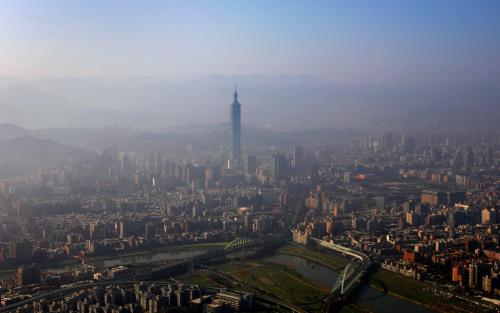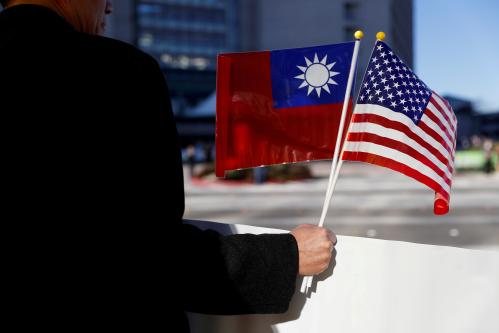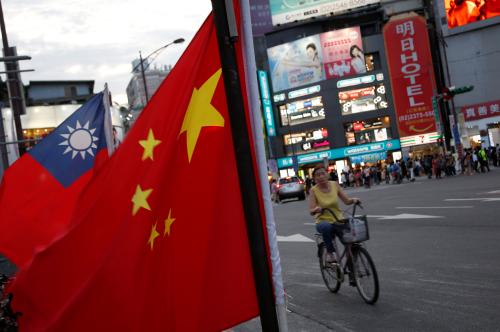Secretary of State Mike Pompeo’s January 9 announcement that the United States was terminating restrictions on U.S. government contacts with Taiwan officials generated a wave of headlines. Some celebrated an end to long-overdue restrictions on U.S.-Taiwan official contacts, and others warned of a rising risk of a cross-Strait crisis.
What exactly was the significance of Pompeo’s announcement? How are Taipei and Beijing likely to respond? What should the Biden administration do when it takes office January 20?
What happened?
When the United States and the People’s Republic of China established diplomatic relations in 1979, Washington pledged that it would conduct unofficial relations with the people of Taiwan. The United States Congress legislated that the United States do just that, through its enactment of the Taiwan Relations Act.
During the intervening years, the United States government developed guidelines to define what interactions with Taiwan would be permissible within an unofficial relationship. The Clinton administration formalized such guidelines via a comprehensive interagency Taiwan policy review in 1994. Since then, “contact guidelines” have steadily evolved to broaden the scope of unofficial contacts, largely without fanfare. As but one example, before the 1995-1996 Taiwan Strait crisis, U.S.-Taiwan security discussions focused primarily on arms sales. The crisis demonstrated the need for broader consultations on the defense of Taiwan. Following the crisis, new security dialogue mechanisms were initiated without fanfare to do just that.
Over time, a dense architecture of dialogues developed to support communication between Washington and Taipei on a broadening array of issues. This steady expansion of U.S.-Taiwan engagement strengthened ties without generating significant friction with Beijing, given that much of the interaction between U.S. and Taiwan officials was conducted outside of the public eye.
During the latter half of the Trump administration, Secretary Pompeo and members of his staff initiated an internal review of existing contact guidelines with a view toward finding ways to demonstrate more visible support for Taiwan. The completion of this internal policy review coincided with the waning days of the Trump administration and followed Joe Biden’s certification as president-elect.
Secretary Pompeo thus faced a choice between:
- Doing nothing, accepting that time had run out for announcing new policy initiatives on sensitive matters of national security;
- Preparing a detailed recommendation for his successor on how to update existing contact guidelines for relations with Taiwan;
- Instructing his staff to promulgate an internal update of contact guidelines for Taiwan within the United States government, and privately notifying Taiwan counterparts of the change in policy; or
- Releasing a press statement announcing that all contact guidelines for relations with Taiwan are null and void.
Just three days after the occupation of the U.S. Capitol by a mob of insurrectionists, and with 11 days left in office, the Trump administration in disarray, the president disengaged from policy decisions, and questions swirling about the president’s potential removal from office, Pompeo chose the fourth option. He did so without any apparent consultation with his successors, despite the fact that they — not he — will face the fallout of his decision.
The press statement that Pompeo released was vaguely written and internally inconsistent. It noted at one point that the United States would unshackle itself from its previous policy restraints on contact with Taiwan, yet at another point instructed that all contacts with Taiwan be handled through the American Institute in Taiwan (AIT), the non-profit organization established by the Taiwan Relations Act to manage America’s unofficial relations with Taiwan. Thus, it may end up being the case that Pompeo did little more than transfer oversight responsibility for contacts with Taiwan from the State Department to AIT.
Taipei’s response
Taiwan officials’ initial reactions were ebullient. Taiwan’s representative in Washington, Bi-Khim Hsiao, and Taiwan’s foreign minister, Joseph Wu, both released appreciative messages for the policy adjustment. Taiwan’s vice president, William Lai, went further, tweeting: “Taiwan is a country and a trusted partner, we deserve to be treated as such…”
Against this backdrop, the absence of any statement by President Tsai Ing-wen or the presidential office was notable. Tsai’s decision to refrain from celebrating Pompeo’s announcement was in keeping with her steady, methodical, and balanced style of governance. Having gone through a transition herself, Tsai likely also is attuned to the uniqueness of an outgoing administration launching a policy shift on a sensitive issue in its waning days in office.
Beijing’s response
Beijing’s initial reaction, meanwhile, was shrill. In a widely circulated op-ed, Beijing warned that Pompeo was “pushing the Taiwan question deeper down the road of no return.” The op-ed argued that:
in order to push the incoming Biden administration to overthrow the decisions made in the incumbent government’s last-ditch madness and prevent politicians such as Pompeo from taking actual actions to break the bottom line, China needs to clearly show its resolution to firmly oppose the US’ extreme provocations and counter the US head-on.
China’s Foreign Ministry spokesperson Zhao Lijian responded to a question at the January 11 daily press conference by repeating: “Actions that harm China’s core interests are futile and will be met with resolute responses.”
Beijing’s frustration likely will take more tangible expression around the planned visit of U.S. Ambassador to the United Nations Kelly Craft to Taiwan January 13. In comparable recent visits to Taiwan by senior U.S. officials, Beijing has conducted military operations near Taiwan to coincide with such trips as a signal of its displeasure.
Beijing likely will try to punish Taipei for Washington’s policy adjustment.
Beijing likely will try to punish Taipei for Washington’s policy adjustment. Doing so would accord with a pattern of Beijing taking its anger out on Taiwan in response to visible actions by the United States to support Taiwan, such as arms sales or senior-level visits. For example, Beijing already has poached five of Taiwan’s diplomatic allies in the past four years; it may seek to add to that list in the coming weeks.
Beijing will probably refrain from escalatory responses against the United States until it has an opportunity to take the measure of the incoming Biden administration. Chinese officials recognize that Pompeo’s views will not carry policy weight beyond January 20. Beijing likely will not want to preemptively foreclose its ability to explore a less confrontational relationship with the United States in the coming years by overreacting to Pompeo’s announcement in the moment.
The Biden administration’s inheritance
After it enters office, the Biden administration will have to decide how to treat Pompeo’s decision to lift all restrictions on contact with Taiwan. The incoming team will have a few options:
- Publicly countermand Pompeo’s announcement;
- Uphold Pompeo’s decision and allow the U.S.-Taiwan relationship to operate without guidelines on the level, frequency, or public profile of contacts between officials;
- Instruct the State Department to resume reviewing and approving contacts from across the United States government with Taiwan counterparts to ensure that such contacts adhere to the spirit of longstanding policy, if not necessarily the letter of past contact guidelines; or
- Use Pompeo’s announcement as a spur to launch a Taiwan policy review to develop updated guidelines for contacts with Taiwan counterparts based on a fresh assessment of America’s interests and priorities in its unofficial relationship with Taiwan.
Given that countermanding Pompeo’s announcement would set the U.S.-Taiwan relationship off on a bad foot and embracing Pompeo’s decision could invite risks of uncoordinated actions generating unintended escalatory pressure in the Taiwan Strait, the first two options are low-probability scenarios. This leaves the third or fourth options as more likely, and those options are not mutually exclusive. The Biden administration could, for example, use the third option as a placeholder as it updates contact guidelines to define unofficial relations with Taiwan going forward.
The Biden administration likely also will need to settle on how it speaks privately and publicly about cross-Strait relations. Chinese officials will use initial private diplomatic exchanges with the Biden administration to press them to publicly repudiate Pompeo’s decision. The Biden team should respond to such requests by emphasizing that the more Beijing takes actions to threaten or marginalize Taiwan, the greater the need Washington will feel to expand engagement and ramp up visible support for Taiwan.
Already, the Biden transition team appears to have struck a balanced public posture. It has reiterated Biden’s support for the “One China” policy and also for “peaceful resolution of cross-Strait issues consistent with the wishes and best interests of the people of Taiwan [emphasis added].” (Previous U.S. policy called for “peaceful resolution of cross-Strait issues consistent with the wishes of people on both sides of the Taiwan Strait.”) The Biden transition team’s statement simultaneously reassures Beijing and reaffirms to the Taiwan people that his approach will be guided by concern for their well-being. Such an approach might not anger or excite, but maybe that is not all bad at this current moment.
The Brookings Institution is committed to quality, independence, and impact.
We are supported by a diverse array of funders. In line with our values and policies, each Brookings publication represents the sole views of its author(s).











Commentary
After lifting restrictions on US-Taiwan relations, what comes next?
January 11, 2021